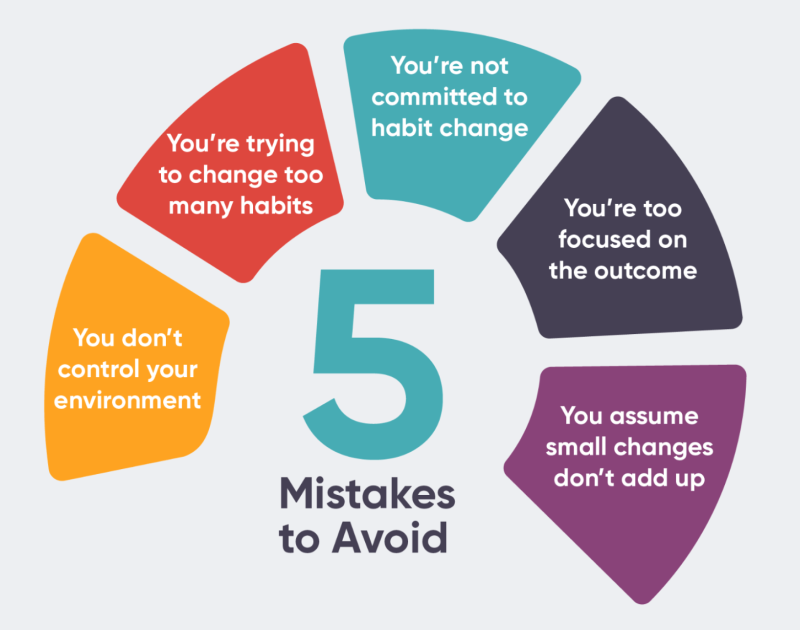

Our habits shape who we are. Though we admit, forming positive habits isn’t always easy.
Depending on whether they are healthy habits or bad habits, habits determine if we’re going to be happy or unhappy. Healthy or unhealthy. Tired or well-rested. Strong or weak. The power of habits is far-reaching.
Habits shape our attitudes, actions, and decision-making abilities. And they affect every aspect of our lives.
But before we can build good habits, we need to understand what habits are and how they’re formed. We also need to know what mistakes we should avoid in the process.
Let’s take a look at the art of building good habits, including the science behind them and how you can set yourself up to successfully form new, better ones today.
What is a habit?
A habit is a tendency to do something, whether harmful or health-promoting.

A good habit will help you reach your goals, develop both personally and professionally, and feel fulfilled. However, not all habits are good.
Habits are driven by reward-seeking mechanisms in the brain. They’re often triggered by something specific. For instance, walking past a cafe and smelling coffee beans can trigger you to want a cup. Feeling stressed at work can trigger you to smoke a cigarette.
After a while, habits become a repetitive part of your lifestyle.
Here are some other examples of habits:
- Brushing your teeth after eating a meal
- Putting on your seatbelt when you get inside a car
- Drinking a glass of wine when you get home from work
- Eating sugary or salty foods when you’re stressed at work
- Fidgeting with your notebook during a meeting
Forming habits is the brain’s way of being more efficient. As far as the brain is concerned, the more tasks you can complete without wasting time thinking about them, the better.
And our brain’s tendency toward efficiency can be positive.
For instance, drinking a green smoothie every morning benefits your health. And not having to relearn how to drive your car every day means you have reliable transportation.
Of course, this efficiency can also be negative.
For instance, biting your nails every time you have a meeting at work can wreak havoc on your nails. Or not brushing your teeth after eating can lead to tooth decay.
What’s the difference between habits and routines?
The main difference between a habit and a routine is awareness. Both are regular, repeated actions. But while habits run on autopilot, routines are intentional.
Routines need deliberate practice, or they’ll eventually die out. But a habit happens with little or no conscious thought.
For instance, a gratitude practice requires intention and effort. It won’t run on autopilot. The same is true for exercise. You’re not going to start exercising on autopilot. But (if you have the habit), you’ll grab a cigarette on autopilot.
For a routine to turn into a habit, the behavior will need to happen with little or no thought. For instance, let’s say you add drinking green juice to your morning routine. If one day you wake up and make green juice without thinking about it, you can consider it a habit.
The science of habits
In this section, we’ll break down the four stages of habit formation.
How do habits form?
Habit-forming is the process in which behaviors become automatic. It can be an intentional process, or it can happen unplanned.
For instance, you were most likely taught to wash your hands as a child. And after a while, washing your hands became automatic. It wasn’t intentional — it happened after lots of repetition.
Replacing your nightly glass of wine with a glass of water, on the other hand, is intentional. So is replacing your morning cup of caffeinated coffee with decaf.
One thing to keep in mind about the habit-forming process is that it doesn’t happen occasionally. It’s an endless feedback loop that’s running and active during every moment you’re alive. That brings us to the habit loop.
What’s the habit loop?
Charles Duhigg, author of “The Power of Habit,” says that at the core of every lasting habit is a psychological pattern called the ‘habit loop.’
The habit loop includes a four-step pattern that all habits proceed through. The four stages are always the same and in the same order:

- Cue/trigger
Your mind constantly analyzes your environment for hints of where rewards are located. The cue is the first sign that you’re close to a reward, like money or love. This step triggers your brain to start a behavior.
Since the cue means you’re close to a reward, it’ll naturally lead to the second step: the craving.
- Craving
Cravings are the motivational force behind every habit. They give you a reason to act. However, what you’re craving isn’t the habit itself but rather the change in state you get from it.
You crave a glass of wine because of the relief it brings. You crave wearing your seatbelt because it makes you feel safe.
In the end, cravings stem from a desire to change your internal state.
- Response
The response is the habit you perform. It can take the form of a thought or an action. Responding depends on how motivated you are and how challenging it is to perform the behavior.
For instance, if an action requires more effort than you’re willing to put in, you won’t do it.
- Reward
The goal of every habit is the reward. The cue notices the reward, the craving wants the reward, and the response obtains the reward.
For instance, let’s say you’re walking around town, and you come across a bakery. The cue would be noticing the bakery. The craving would be wanting a piece of chocolate cake. And the response would be going inside to order and eat a slice of cake.
We chase rewards for two reasons: they satisfy our cravings, and they teach us which actions we should remember in the future.
How long does it take to form a new habit?
In a study run back in 2009, researchers at University College London found that, on average, building habits takes around 66 days before the behavior change becomes automatic.
However, the choice of habit was a major part of how long it actually took (between 18 and 254 days).
In short, some habits are harder or easier to form than others.
For instance, replacing coffee with green tea might be faster than giving up caffeine altogether. And replacing nicotine with hard candy might be slower than replacing it with nicotine patches.
In the end, how long the habit takes to form will depend on how motivated you are and how much effort it takes to perform a behavior.
Changing habits: 5 mistakes to avoid
Here are five mistakes to avoid when you want to replace an existing habit with another:

1. You’re not controlling your environment
Failing to control your environment is one of the biggest threats to changing an old habit.
If you’re still going to grab fast food with co-workers after a bad day, you probably won’t stop stress eating and adopt intuitive eating. Instead, opt to hang out with friends at a different location like a cafe or a park.
The same is true for any habit. Make sure your environment supports the changes you want to make.
2. You’re trying to change too many habits
Focusing on too many behavior changes at once can make you feel overwhelmed and anxious. As we mentioned earlier, if an action requires more effort than you’re willing to put in, you won’t do it.
Instead, focus on changing one behavior at a time. Once that habit becomes solid, move on to the next behavior.
3. You’re not committed to habit change
A healthy habit takes time and repetition to form. This means being patient and giving yourself some time to achieve your goals. Remember, it takes between 18 to 254 days to form a new habit.
4. You’re too focused on the outcome
Too many of us focus on short-term results, like losing 10 pounds for a beach trip or saving just enough money for a new computer. But the key to lasting change is a lifestyle change. Instead of focusing on short-term outcomes, focus on adapting your lifestyle.
5. You assume small changes don’t add up
Sometimes we give up on changing a habit before we even start. We assume that we’ll need to make drastic changes that are too difficult. But every day, we have the chance to get a little better or a little worse.
Instead of worrying about the big picture, start with small, realistic changes. Once those small changes have become second nature, you can slowly make bigger ones.
Building good habits in 7 steps
When building habits, you will often be replacing old ones. Here are seven ways to replace bad habits with healthier ones:
- Eliminate triggers
- Reduce cravings
- Make a negative habit difficult
- Uncover the root
- Adopt healthy routines
- Swap a bad habit for a better habit
- Build intrinsic motivation

1. Eliminate triggers
Identify the people, places, and activities that are linked in your mind to bad habits. Then change your behavior toward those.
For instance, if you have a shopping addiction, avoid shopping malls. If you want to quit smoking, don’t go outside when your friends take a smoke break.
Chronic stress can also trigger poor behavior. Make sure to actively manage your stress levels to avoid triggers.
2. Reduce cravings
Remember, cravings stem from a desire to change your internal state. This means you can reduce cravings by identifying how you want to feel. Then, use a healthier action to achieve that feeling.
For instance, if you’re craving relaxation, take a bath instead of smoking. If you’re craving energy, eat a banana instead of drinking your third cup of coffee for the day.
3. Make a negative habit difficult
Habits can only exist if the behavior is easy enough to engage in. If you make the behavior difficult, you won’t be able to do it. For instance, if you have a bad habit of staying up too late, start work earlier in the morning.
If you know you’ll be physically exhausted and running on a few hours of sleep, you’ll think twice before staying up late.
4. Uncover the root
Uncovering the root of your bad habits is one of the most important ways to change them. For instance, maybe you’ll discover that you stress eat because you need coping tools.
Knowing that a lack of coping tools is the root of your habit, you can nurture your mental well-being in better ways. For instance, you can use self-care practices like mindful breathing to cope with stress.
5. Adopt healthy routines
Building good habits boils down to lifestyle choices. And one of the best ways to change your lifestyle is by improving your daily routine. Map out your day and integrate healthy practices where they make sense.
For instance, eat a vegetable and a fruit when you wake up. Take a restorative nap on your lunch break. And take a quiet walk in the evenings. Make sure that the practices you choose are realistic and healthy.
6. Swap a bad habit for a better habit
Sometimes the easiest way to change a habit is by swapping it for a better one. For instance, instead of eating a slice of cake every night, swap it for a baked cinnamon apple. Instead of drinking a glass of wine, swap it for a glass of sparkling water.
7. Build intrinsic motivation
To build intrinsic motivation, you’ll need to believe two things: you have the choice and freedom to act how you want, and a task will teach you something new and make you a better person.
One of the best ways to believe these two things is by learning how to deal with negative emotions.
You’ll also need a way to measure progress towards your new habit. Seeing progress is a major motivator. This can be as simple as writing it down and hanging it on your mirror. It could also be making a fancy chart or spreadsheet.

And finally, take intrinsic motivation to the next level by making your goal public. Tell a close friend or announce it on social media. Public commitment to your personal goals works as a powerful accountability partner.
How to maintain a habit
Now that you know how to build good habits, let’s take a look at some tips for you to maintain your new behavior:
1. Make it part of your schedule
It can be easy for new positive habits to fall by the wayside when you don’t do them regularly. When we have a lot on our plate, life can get in the way of habit building. To avoid this, make your new habits part of your schedule.
For example, you may have taken up virtual workouts to achieve a good work-life balance during COVID-19. To practice self-management and make sure you maintain this healthy habit, incorporate it into your daily routine.
Use time management techniques to effectively manage your time and prioritize your habits.
2. Create a supportive environment
Surround yourself with like-minded people who have similar goals to you. Why? Because as humans, we are greatly influenced by what others around us are doing or feeling.
A study found that the exertion of mental effort is contagious. Simply doing a task next to a person who exerts a lot of effort will help you do the same.
Being around like-minded individuals is also encouraging. For example, you may have formed a habit of going for a run in the morning. Making connections with other runners will give you that extra energy and motivation to stick to your running habits.
Being around a positive group of people who share similar goals and interests can be the single greatest catalyst to help you maintain your habit.
Tell your family, friends, and colleagues what your plans are to maintain your new habit. Sharing your habit goals provides accountability and support for your habit maintenance.
3. Use reminders
One of the trickiest parts of maintaining a habit is remembering to do it in the first place. This is especially true when you’re in the beginning stages of your habit. As we’ve mentioned above, it takes time for actions to turn into habitual behaviors.
To help maintain your habit, set reminders for yourself. This could be a visual reminder like a post-it on the fridge or your mirror.

Or why not use technology to your advantage? Set up reminders on your phone or download one of the many habit tracking apps available. Some wearable stress trackers and sleep trackers have the functionality to set reminders.
You can also set reminders about why you’ve decided to commit to your new habit, making you more motivated to stay on track and maintain it.
4. Practice self-compassion
Building a habit is difficult. But maintaining it can even be more daunting.
Putting too much pressure on yourself to maintain your habit can be counterproductive. For example, if you fail to keep up with your habit, it can be tempting to focus only on the failure. Negative self-talk and automatic thoughts like “I’ve failed again” or “I’ll never succeed” will only set you back.
Instead, avoid being too critical of yourself by practicing self-compassion and emotional regulation. Remind yourself that habit formation and maintenance is a journey. And failure is a natural part of the journey.
Don’t beat yourself up, and focus on what future actions you can take.
Building good habits: an invitation to grow
Building good habits is one of the main pillars of personal growth. To build better habits, you should shape your environment in a positive way and take it one step at a time.
Ready to form better habits? At BetterUp, we love helping individuals reach their fullest potential.









You must be logged in to post a comment Login